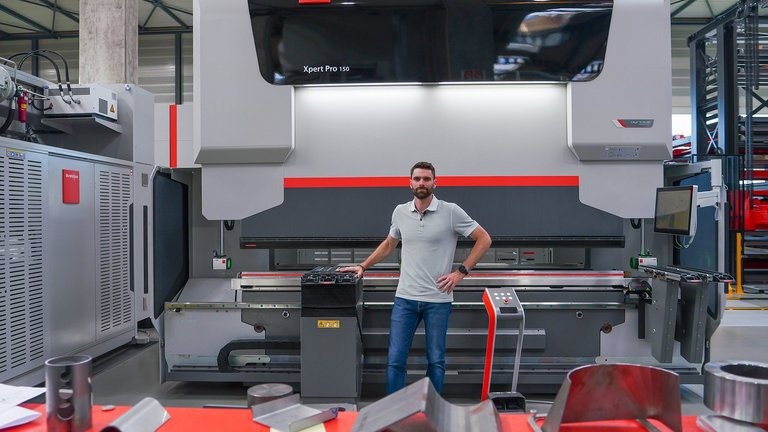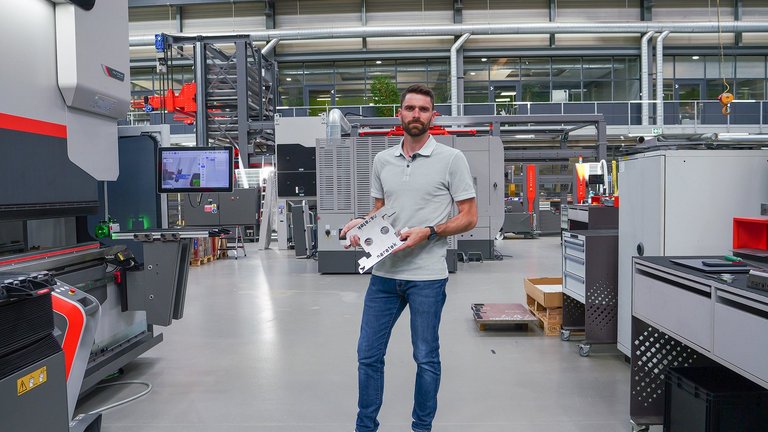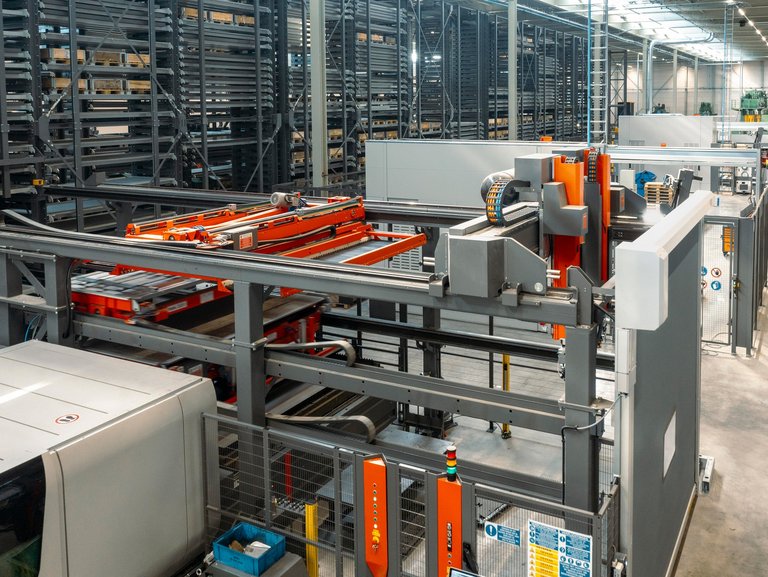Net Zero Roadmap
Green Steel Revolution
Steel production is responsible for ten percent of CO2 emissions worldwide. Alternative manufacturing processes exist, but the investments are high and the road is long. Two experts provide insights.
Does green steel bend differently?
Our world is built on steel. From buildings and power lines to the automotive industry and shipbuilding to medical, office and computer technology, there is no area of our lives that does not contain steel in some form. "Steel has thousands of applications," says Wilfried Liegard, a member of a research team at mechanical engineering company Bystronic. He says steel offers so many different properties: it can be as rigid as it is flexible, absorbent or resilient, easy to shape or dimensionally stable. Added to this is the fact that iron ore is almost inexhaustibly available on our planet. "Our world is built on steel," he says.
And the hunger for steel is growing: in the last 50 years, steel production has increased about sixfold. In 2022, over 1.8 billion (!) tons of steel were produced, according to worldsteel.org - two-thirds of it in China. Steel production therefore has a decisive influence in achieving the climate targets. Worldwide, steel production is responsible for around eight percent of CO2 emissions, in Europe the share is four percent. In the classic manufacturing process, 1.8 metric tons of CO2 are produced simultaneously for each metric ton of steel. Or as Christian Leinenbach, metals expert at the Empa research institute and lecturer at EPFL, pointedly puts it, "It's actually CO2 production. Iron is the useful byproduct."
A brief excursion into the ancient method of iron production: iron ore is brought into contact with carbon under high heat - this takes place in blast furnaces at temperatures of up to 1,800 degrees. The infernal heat awakens a hunger for oxygen in the carbon, which gets it from the iron ore. As a result, CO2, slag and pig iron are formed at the end of the process. To remove the remaining carbon from the pig iron and obtain steel, oxygen is injected in a separate step. This binds the carbon - further CO2 and low-grade structural steel are produced. Refining processes are necessary to obtain stainless steel.
A second process goes by the name of electrometallurgy or electric arc process. Using graphite electrons and electricity, a high-energy arc is created that melts the steel. Although the electric arc process operates in a largely CO2-neutral manner, it is only suitable for processing recycled steel and scrap.
Does green steel bend differently?
Back to climate protection. As in other areas of life, pressure is growing in the steel industry to become climate-neutral. But how? The magic word is fossil-free, or "green" steel - steel whose production releases as little CO2 as possible into the air. Christian Leinenbach names several ways to achieve this. On the one hand, oxygen can be removed from the ore using hydrogen instead of carbon. "The reaction with hydrogen produces not pig iron but a porous granulate," he says. This can then be processed into steel in the electric arc furnace using electricity - the energy requirement is lower than that of the blast furnace. The important thing is that the electricity for the arc furnace and the production of the hydrogen must come from renewable energy sources. As an additional means on the road to CO2-neutral steel production, Leinenbach mentions carbon capture technologies, such as those being built by the Swiss startup Climeworks. Produced CO2 is captured here and stored in the soil, for example.
Wilfried Liegard goes even further: "In the end, the whole chain should be green, including transport," he says. If the iron ore is mined in India, processed into pig iron in the Middle East and refined into steel in France, the transport of the material puts an additional burden on the climate. The mines would also have to become greener, for example by using electric machines to mine the ore. Last but not least, these machines would themselves have to be made of green steel.
For the research team at Bystronic, the material properties are also of particular interest. Can green steel be cut and bent in the same way as conventional steel? "Green steel is chemically and physically practically the same as fossil steel," says Liegard. Cutting, he says, is not a problem. Bending, on the other hand, raised questions: does the green steel contain larger residues of hydrogen, for example? "We compare curves and try to conclude how the steel behaves at different pressures," he says. Nor, he adds, can one simply speak of steel as a material. "There are about 3000 different steels," adds Empa researcher Leinenbach. It is a group of materials, he says.




Billions in investment
However, green steel is not yet being produced in large quantities. The Swedish company SSAB is currently leading the way - but with a total production capacity of just under nine million metric tons, it is a small fish in the pond. In 2020, the steel giant China Baowu Group produced over 115 million metric tons, while Arcelor Mittal managed 78.5 million metric tons. Nevertheless, SSAB is leading the way and, together with partners, has launched the Hybrit project. In Luleå, Sweden, a first pilot plant with a steel production facility and hydrogen storage facility has been built, with electricity coming from renewable sources. In 2026, SSAB aims to launch the first fossil-free steel on the market, and by 2030 SSAB's steel production should be largely climate-neutral. The green steel is in demand: in October 2021, Volvo Group unveiled the first commercial vehicle and in 2022 the first truck made with (not yet commercially produced) green steel from SSAB. Mercedes will use fossil-free steel for prototype parts for cars as a first step.
"The biggest challenge is scalability of production," Liegard says. The change would require high investments, he calculates, at around one billion U.S. dollars per steel company. "We therefore expect steel to become about 30 percent more expensive" he says. Leinenbach confirms this figure and says it is "a balancing act." The auto industry, for example, would either have to let the more expensive steel flow into its pricing or use less steel. Electric cars would have a certain advantage, as they do not contain an engine block. Last but not least, recycling needs to be considered, he says. Every ton of steel already contains about thirty percent recycled steel, he says, and this figure could be improved. "We have to look at the material as a recyclable material," Leinenbach concludes.

